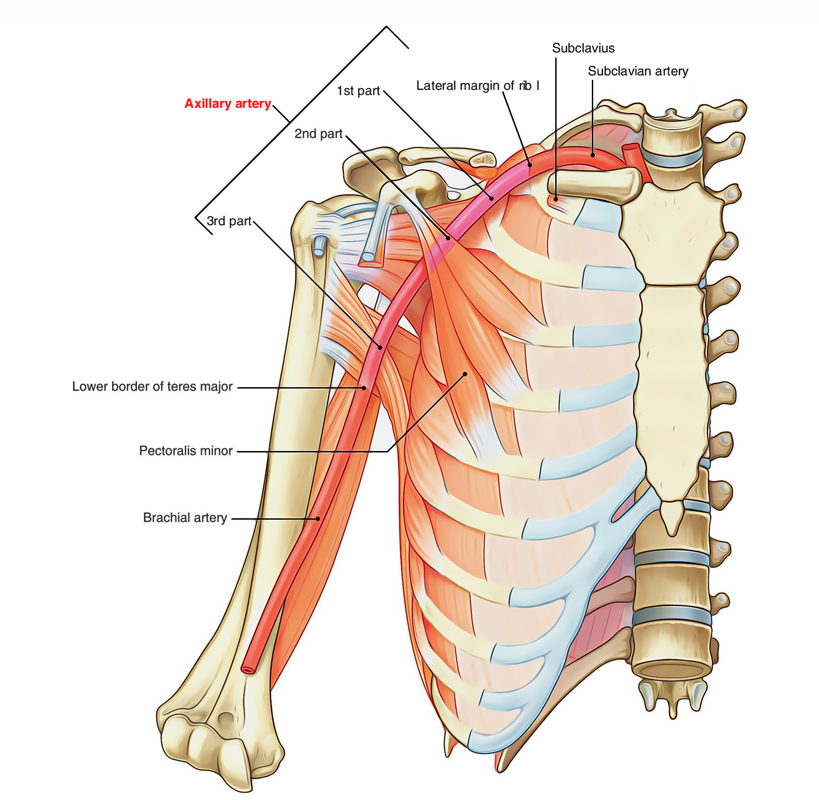Makindo Medical Notes"One small step for man, one large step for Makindo" |
|
|---|---|
| Download all this content in the Apps now Android App and Apple iPhone/Pad App | |
| MEDICAL DISCLAIMER: The contents are under continuing development and improvements and despite all efforts may contain errors of omission or fact. This is not to be used for the assessment, diagnosis, or management of patients. It should not be regarded as medical advice by healthcare workers or laypeople. It is for educational purposes only. Please adhere to your local protocols. Use the BNF for drug information. If you are unwell please seek urgent healthcare advice. If you do not accept this then please do not use the website. Makindo Ltd. |
The Axillary Artery
-
| About | Anaesthetics and Critical Care | Anatomy | Biochemistry | Cardiology | Clinical Cases | CompSci | Crib | Dermatology | Differentials | Drugs | ENT | Electrocardiogram | Embryology | Emergency Medicine | Endocrinology | Ethics | Foundation Doctors | Gastroenterology | General Information | General Practice | Genetics | Geriatric Medicine | Guidelines | Haematology | Hepatology | Immunology | Infectious Diseases | Infographic | Investigations | Lists | Microbiology | Miscellaneous | Nephrology | Neuroanatomy | Neurology | Nutrition | OSCE | Obstetrics Gynaecology | Oncology | Ophthalmology | Oral Medicine and Dentistry | Paediatrics | Palliative | Pathology | Pharmacology | Physiology | Procedures | Psychiatry | Radiology | Respiratory | Resuscitation | Rheumatology | Statistics and Research | Stroke | Surgery | Toxicology | Trauma and Orthopaedics | Twitter | Urology
Related Subjects: |The Coronary Arteries |The Axillary Artery |The Brachial Artery |The Carotid Artery |The Femoral Artery |The Popliteal artery |The Subclavian Artery |The Iliac Artery |The Brachial Artery |The Axillary Artery |The radial and Ulnar Artery
The axillary artery is a major blood vessel that supplies oxygenated blood to the upper limb. It is a continuation of the subclavian artery and extends from the lateral border of the first rib to the lower border of the teres major muscle, where it becomes the brachial artery.
Anatomy of the Axillary Artery
- Origin :
- The axillary artery is a direct continuation of the subclavian artery after it passes the lateral border of the first rib.
- Course :
- The artery travels through the axilla (armpit) and is divided into three parts based on its position relative to the pectoralis minor muscle:
- First Part: Located between the lateral border of the first rib and the medial border of the pectoralis minor muscle.
- Second Part: Posterior to the pectoralis minor muscle.
- Third Part: Extends from the lateral border of the pectoralis minor to the lower border of the teres major muscle.

Branches of the Axillary Artery
- First Part :
- Superior Thoracic Artery : Supplies the upper regions of the chest wall and pectoral muscles.
- Second Part :
- Thoracoacromial Artery : Divides into four branches - pectoral, deltoid, clavicular, and acromial - supplying the pectoral and deltoid regions.
- Lateral Thoracic Artery : Supplies the lateral chest wall and the breast.
- Third Part :
- Subscapular Artery : The largest branch, further divides into the thoracodorsal artery and the circumflex scapular artery, supplying the scapular region and latissimus dorsi muscle.
- Anterior Circumflex Humeral Artery : Wraps around the front of the surgical neck of the humerus, supplying the shoulder joint and deltoid muscle.
- Posterior Circumflex Humeral Artery : Larger than the anterior, it travels with the axillary nerve through the quadrangular space to supply the deltoid and shoulder joint.
Functions of the Axillary Artery
- Oxygenated Blood Supply :
- The primary function of the axillary artery is to provide oxygenated blood to the upper limb, shoulder, and thoracic region.
Clinical Relevance
- Axillary Artery Injury :
- Injuries to the axillary artery can occur due to trauma such as fractures, dislocations, or penetrating injuries.
- Symptoms: May include pain, swelling, decreased pulse, and ischaemia of the upper limb.
- Treatment: Surgical repair or vascular reconstruction is often required.
- Aneurysms :
- An aneurysm in the axillary artery can lead to compression of surrounding structures or rupture.
- Symptoms: May include a pulsatile mass, pain, and ischaemia.
- Treatment: Surgical intervention is typically required.
- Thoracic Outlet Syndrome :
- Compression of the axillary artery (along with veins and nerves) as it passes through the thoracic outlet can lead to thoracic outlet syndrome.
- Symptoms: Include pain, numbness, and weakness in the upper limb.
- Treatment: Physical therapy, pain management, and sometimes surgical decompression.
Summary
The axillary artery is a critical blood vessel supplying the upper limb, shoulder, and thoracic region. Originating from the subclavian artery, it travels through the axilla and gives off several important branches. Understanding the anatomy and clinical relevance of the axillary artery is essential for diagnosing and managing conditions such as injuries, aneurysms, and thoracic outlet syndrome.